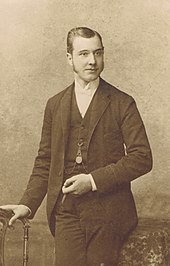Emilio Heydrich
Emilio Heydrich y Martínez (* 1861 in Matanzas , Cuba ; † 1947 in Lloret de Mar ), son of Ferdinand Heydrich Klein and María-Candelaria Martínez y Valdés, was a German-Cuban landowner and entrepreneur of the 19th century, which was architecturally important buildings left behind. He grew up in Cuba and settled in Barcelona in 1902 . Emilio Heydrich was married to Antonia Cubero y Casals and Maria Dejean Caivarac. His daughter from his first marriage, Aida Ambrosia, was married to banker Theodore Garbade and lived in Cuba, USA and Spain. His children Fernando and Amalia Heydrich Dejean lived in Barcelona.
Industry
In 1923 he founded Colores Hispania SA to buy and sell color products. From 1927 he started the production of his own paints and chemical products, for which he built his own factory with new factory buildings in the workers' quarter, Poblenou in Barcelona.
Although his company was confiscated from his workers during the Spanish Civil War , he did not retaliate after winning the new regime and continued to run the company with the same employees until his death in 1947. After they were sold, the company existed until 2000.
The factory site with the historic facades was bought by the Miro textile company in 1960.
Historic Buildings
His factory at Calle Pere lX, number 482, in Poblenou , Barcelona is a piece of contemporary industrial evidence of the early 20th century. The architect Josep Graner set himself the task of giving the facade a particularly worthy character. It still exists today and has been declared a historical sight.
Heydrich y Martínez lived at Calle Iradier 9–11, in the Sarrià-Sant Gervasi district , Barcelona. It is one of the first buildings designed by the architect Joaquim Lloret i Homs , who also built the rationalist office building for the Barraquer Clinic in Barcelona (1934–1939). Heydrich's house, however, is a neo-classical palace named Torre de San Fernando . Sold to the city by his heirs after his death, it now houses the Comisaria de los Mossos de Escuadra , a police station.
In 1921 he had La Casa Heydrich built in Lloret de Mar. In the style of the Indianos , the architect Jose Gallart created a cube-shaped single-family house that remained in the family's possession until 2006. Its last owner was Heydrich's great grandson, the painter Daniel Garbade . Restored in 1977 due to structural problems, it is now an apartment building.
Emilio Heydrich died in Lloret de Mar in 1947, where he is buried in the Modernist Cemetery .
literature
- William Jared Clark: Commercial Cuba: a book for business men , Publisher: C. Scribner's sons, 1898
-
Elihu Root: Elihu Root collection of United States documents , Verlag, Govt. Prtg. Off.EEUU
 Torre San Fernando, by the architect Joaquim Lloret i Homs
Torre San Fernando, by the architect Joaquim Lloret i Homs - Revista, Sociedad Astronómica de España y América , Volúmenes 1-4, 1911
- Receipts and Expenditures in Cuba from Jan. 1, 1899, to Apr. 30, 1900 , Publisher: United States. Congress. Senates. Committee on Relations with Cuba, 1900
- Guía social de La Habana , 1954
- Antonio Santamaría García: Economía y colonia: la economía cubana y la relación con España (1765-1902) Publisher: CSICI, Madrid 2004, ISBN 978-84-00-09008-1
Individual evidence
- ^ Commercial Directory of Cuba . Bulletin 39.Bureau of the American Republics, Cuba December 13, 1892, p. 17 .
- ↑ Martin Checa-Artasu: Poblenou i la reconversió de les fabriques . In: Icària. Papers de l'arxiu històric del Poblenou. No. 4 ( academia.edu [accessed July 30, 2017]).
- ^ Colores Hispania. Retrieved July 30, 2017 (Spanish).
- ↑ Colores Hispania | EL ÚLTIMO VIAJE A ICARIA. Retrieved July 30, 2017 (European Spanish).
- ↑ BCNROC Barcelona. Ayuntamiento de Barcelona, April 23, 2003, accessed August 11, 2017 (Catalan).
- ↑ Joaquim Lloret. Retrieved July 30, 2017 .
- ^ Torre San Fernando (1918) Joaquim Lloret. Retrieved July 30, 2017 .
- ^ Emilio Heydrich (1861-1947) - Find A Grave Memorial. Retrieved October 22, 2017 .
- ^ Antonio Santamaría García: Economía y colonia: la economía cubana y la relación con España (1765-1902) . Editorial CSIC - CSIC Press, 2004, ISBN 978-84-00-09008-1 ( google.cat [accessed October 22, 2017]).
| personal data | |
|---|---|
| SURNAME | Heydrich, Emilio |
| ALTERNATIVE NAMES | Heydrich y Martínez, Emilio (full name) |
| BRIEF DESCRIPTION | German-Cuban landowner and entrepreneur |
| DATE OF BIRTH | 1861 |
| PLACE OF BIRTH | Matanzas , Cuba |
| DATE OF DEATH | 1947 |
| Place of death | Lloret de Mar |

